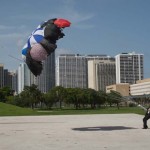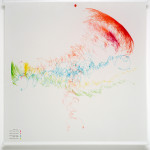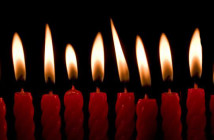Andrew Mowbray is a sculptor in the tradition of Joseph Beuys, whose objects exist to facilitate a performative act, and remain as tangible evidence of that experience. His new body of work, Tempest Prognosticator, is currently on view at the DeCordova Museum. We met at his studio in the Distillery to discuss weather, leeches and Transcendentalism.
MN: Can you tell me about the origins of Tempest Prognosticator?
AM: Well, the Tempest Prognosticator show deals with issues of weather, to a certain extent. I wouldn't say it's about global warming, but it's certainly about my feelings toward our contemporary relationship with weather.
The whole show came about in an odd way, because two years ago I was in Miami for the big art fairs. Unlike Boston, the weather in Miami in December was really nice, and I just wanted to go to the beach, but instead I spent two days inside in these white hermetic boxes looking at stuff that was there to be sold. After that experience, I made it my goal to use the next summer, up here in Boston, to just get outside and have a relationship with the weather, and the wind, and somehow have a more direct experience with these things than I have inside my studio.
So that was the origin of the work. I've been fascinated by Weather.com and things like that, thinking about how we have this disconnect when we look at these icons on a screen. I started to pay attention to those, and to look at what was going on outside, and realized that they exist to make us feel better. It's a form of control, these little icons that sanitize the weather to a certain extent. But there's also a certain amount of anxiety that we have, instead of just accepting the weather for what it is.
One of the first pieces I made was really just the most direct machine I could make, was a very simply drawing mechanism to record the wind.
MN: So that resulted in those wind drawings in the show, the colorful swirling pieces?
AM: Yeah, it made those colorful pieces. For me, I wanted this experience outside with the wind. I've always been interested in having these experiences with the objects I create, I'm not satisfied with creating something that is just an aesthetic object that ends up in a gallery. I guess I do it to a certain extent. But, I know that even if I have this performance element, which is the real interest for me with these objects, I know that they are just going to become aesthetic objects that don't have a hands-on, tangible functionality once they are in the gallery.
MN: Which leads me to jump a little bit backwards in your body of work to the Bathyscape installation from Space Other. That piece was very much about this difficult relationship between your work and what a gallery space is supposed to be.
AM: Sure, I mean I have some issues with it because this is the world that I do my thing in, either a gallery or a museum. Sometimes my work is outside or in other locations, and that interests me a lot, but as artists I think that's our main mode of display, most of the time, the gallery or the museum. So that was a real interest with that piece, and it's something that I still have issues with I guess.
Years ago, I made this work that was... well, I consider it pretty sarcastic now. It made fun of art, and there was a lot of puns and art history jokes, things like that. That stuff is still in my work now, not that I make it the focal point of the work, but that sarcastic work was never really satisfying for me. Why make fun of the system, and then present the work within that system? It seems redundant or useless.
So I made the move toward creating work that had this other life outside, work that I had an experience with, a sort of hands-on tangible thing where I didn't know what was going to happen. No longer was it about the crafted object. I like crafted objects but I've reached a point where I can create a lot of things, and for me it's that moment when I interact with the piece, that unknown element, that's what interests me.
With the weather drawings, it was this idea that I created this device that was recording the wind, but really having no idea of what the outcome is going to be.
MN: In the curator's statement (PDF) about your work, Dina Deitsch talks about a device full of leeches that relates to your work....
AM: That's the George Merryweather device from the Victorian era, which was called The Tempest Prognosticator. That's where the name of the show came from.
There was a certain point in time, in the late-1800's, when it was really important for people to somehow create a device that could forecast the weather for ships and travel, things like that. There were a lot of people working on these different devices that would placed along the coastline to forecast an oncoming storm. The George Merryweather piece used a series of bottles that each contained a leech, and there was a little chain that went into the bottle and then up to a bell with a little hammer chime. His theory was that when there was a storm coming, the leeches would become agitated and knock this little whale bone, which would pull this chain and ring this bell. Depending on how many bells were chiming, they would know the severity of the oncoming storm.
To this day they don't know if it actually works. I wouldn't be surprised if it works, but at the same time I think that if I were a leech in a jar I'd probably be agitated already so that might make it unreliable.
The device itself is this really beautiful, ornate object, and that was one thing that I was interested in. I have always felt that during that Victorian era there were more links between aesthetic things and science and art.
MN: That certainly informs your aesthetic, that Victorian look, but you also update it with this white plastic and more contemporary media. How did you end up melding the two?
AM: A few years ago I found myself interested in ornate things from the Victorian era, and the things that were influencing my work or informing my ideas were all coming from that era. For some reason, it kept popping up, I kept reading things like Thoreau, 20,000 Leagues Under The Sea or the Charlotte Perkins Gilman story The Yellow Wallpaper. All of these things kept popping up, and I thought "Oh my gosh, it was done during this time period." So I became interested in that time period, and I started to notice that one could draw a lot of parallels between what was going on over the past few years and what was going on in the Victorian period.
I think that even though many eras will parallel what is happening now, it's more condensed and fast-paced, because of the speed of movement, of the internet and things like that. But there are a lot of things I see, like the relationship between Darwin's The Origin Of The Species and the genetic studies that are going on right now, or the discrepancies between wealth and poverty, I see a whole lot of similarities.
Often, I'll make work I'm interested in and then go back and look at that time period and find relationships. For me, it's not about looking at that period and trying to make work that relates to that, it's about making the work and doing research for the work, and after it's done looking back at that period and finding more parallels.
MN: What are you looking at now that's informing the new projects?
AM: It's interesting, because even though I'm starting to move away from some of this, I've recently been going back and looking at the Transcendentalist movement, in relationship to my wanting to get back in touch with nature. There are definitely direct parallels there, and I hadn't really made the connection. I had looked at Thoreau, but I hadn't really looked at Emerson and the whole Transcendentalist project. But after creating the Tempest Prognosticator show and trying to have this relationship with nature — which I think at this point in time is totally absurd — looking at what the Transcendentalists were trying to do, I recognized that they were trying to do a similar thing.
MN: But this isn't really new for you. In the Palingenesis piece, you had a plastic "Bachelor Suit" and a "Rod and Reel" that you ultimately took to Walden Pond and went fishing. It seems like you were already aware of this a little bit.
AM: For a long time I've had this idea of getting in touch with nature, this notion of returning to it, that in many ways is absurd. There is the absurdity of that struggle in an urban environment, or in today's culture there is this idea of getting back to the woods. I just think it's kind of ridiculous.
That's one reason why I use a lot of plastic in my work, especially the white polyethylene, which is something that is around us everywhere. I think that we don't consider it, but I like it in relationship to this idea of nature. It's a struggle to use, because a lot of people don't accept it as an art-making material — maybe that's wrong to say — but I think we have these traditional notions of what sculpture are made of, like steel or bronze or stone, if you go way back. But we have plastic all around us and I think it is a contemporary art-making material. It's a synthetic material, like the gallery and the museum, which are synthetic spaces.
At the same time, I want to take that material outside. White polyethylene plastic at Waldon Pond is out of its context, it's out in what we consider "nature". In some ways I look at it like Duchamp's Fountain, taking this urinal and bringing it into the gallery, I'm making these objects that are aware — or I'm aware — that they will exist in the gallery or museum context but they are outside and out of place, in the same way the urinal was out of place in the gallery. That's where they have this life, for me, and then they have this resting place in the gallery or museum where they become a static object instead of a functional device that I use to explore.
MN: Normally I try to avoid asking artists about the work of their spouses or studio-mates, because everybody creates and forms their ideas in different ways. But over the summer I interviewed your wife Cristi Rinklin, and she has been making paintings from a similar origin, based on those Hudson River School paintings as another way of getting back to nature, and here you are talking about Transcendentalism. Is that something you talk about when you discuss your work?
AM: No, not really. We talk about art all the time, so maybe this idea is just floating in the house. There are similarities there, certain aesthetic things that we're interested in, but we definitely have some different views on art and what it is. We've discussed this, and I love paintings but I'm not a painter. I question the functionality of them. When I painted years ago, it just wasn't satisfying for me to paint. To have an idea for a painting and then make it happen, even when it's a success, what does it do?
MN: That's an interesting question. What does art do? What do you expect your art to do?
AM: I expect my art to show me something that I didn't know. I expect to have a thought, or even an actual experience, with the piece that I didn't expect to happen. That's why the performance element is very important for me. Some people can have that through a painting, I personally can't. Everyone has their own experience with art, I know that, but for me I expect that interaction. Even if it is just a drawing machine, something simple that creates a moment of chance.
- Andrew Mowbray, Tempest Prognosticator, still from video of performance, 2008.
- Andrew Mowbray, Parachute, performance with parachute made of found umbrellas, 2008.
- Andrew Mowbray, Wind Driven Drawing, acrylic, polycarbonate, steel, mylar, and pens, 2008.
DeCordova Museum and Sculpture Park
"PLATFORM 1: Andrew Mowbray" is on view September 26, 2009 - January 3, 2010 at the DeCordova Museum.
All images are courtesy of the artist and the DeCordova Museum.
A full-length video of Mowbray's Bathyscape, with commentary by Nash, can be found on ASPECT: The Chronicle Of New Media Art volume 12 - "Vital".






